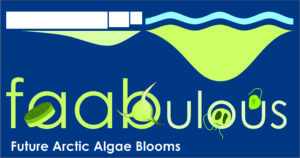FAABulous: Future Arctic Algae Blooms - and their role in the context of climate change

The FAABulous project was funded by the Norwegian Research Council under their OKOSYSTEM call in 2014, and runs from April 2015 until March 2020 (project nr. 243702).
This project studies how ongoing climate change will affect the development of algae blooms in sea ice and water in a future Arctic ocean. To this end, we combine extensive seasonal data collection (automated and sampling) in two Arctic fjords with contrasting environmental conditions, experimental studies, and different modeling approaches. A short summary of the scope of the project is provided below. The practical work started with a cruise to van Mijenfjorden (Svalbard) in september 2015. More information about this (and other field campaigns) can be found here [link to archived old page].
The project is led by Eva Leu (Akvaplan-niva AS), and involves scientists from five Norwegian, and five international (Germany, Poland, UK) research institutions and Universities (see: FAABulous – the team). Our collaboration partners are UNIS, UiT – The Arctic University of Norway , Nord University and NIVA in Norway, as well as Alfred-Wegener-Institute for Polar and Marine Research and Max-Planck-Institute for Meteorology in Germany, the Scottish Association for Marine Sciences and Plymouth University in the UK, and the Institute for Oceanology, Polish Academy of Sciences in Poland.
A summary leaflet of the project is available for download here.
Project summary
The Arctic environment is currently changing at an unprecedented rate, leading to complex and hitherto poorly understood consequences for the marine ecosystems. Small microalgae represent the basis of the marine food web, and are affected by these changes in multiple ways:
(1) altered light conditions owing to a decrease of sea ice extent and thickness,
(2) ocean acidification (OA), resulting from an uptake of anthropogenic CO2 into the water,
(3) invasion of more temperate species from the south through increased transport of water masses from lower latitudes and higher temperatures in Arctic waters.
Together, these three processes are expected to change the timing, species composition, productivity, and food quality of Arctic algal blooms, with far-reaching implications for the entire ecosystem.
This project aims at studying the combined effect of these three processes on Arctic algal blooms in sea ice and water, with a special focus on the control of the onset and development of a bloom. This will be done by combining (i) extensive field studies in two Arctic fjord systems with contrasting environmental characteristics, (ii) experiments to study the combined effect of increased light and CO2 on natural algae communities and single species, and (iii) developing models that allow us to study the relative importance (and joint effects) of different stress factors.
The experimental studies will indicate which algal groups (or species) might be best adapted to tolerate the environmental conditions in the future Arctic ocean, in particular with respect to ocean acidification. These results can be used to identify potential indicator species for OA that can be used in the indicator system for the Barents Sea (developed by Miljødirektoratet).
Furthermore, results from this project will also be used to improve and validate a global model projecting future Arctic sea ice and ocean development with respect to the crucial role of algal blooms.

Seasonal succession of algae blooms in sea-ice covered Arctic marine systems, and their importance for different groups of grazers (from Leu et al. 2015, Prog Oceanogr)

Relevant publications from the project group
· Hegseth, E.N., Assmy, P., Wiktor, J.M., Wiktor, J.M.Jr, Kristiansen, S., Leu, E., Tverberg, V., Gabrielsen, T.M., Cottier, F. (subm.) Phytoplankton seasonal dynamics in Kongsfjorden, Svalbard and the adjacent shelf. Pol Biol
· Leu, E., Mundy, C.J., Campbell, K., Gabrielsen, T., Gosselin, M., Juul-Pedersen, T., Gradinger, R. (2015) Arctic spring awakening – steering principles behind the winter-spring transition in marine ecosystems. Prog Oceanogr 139: 151-170.
· Berge, J., Cottier, F. Darnis, G., Falk-Petersen, S., Gabrielsen, T., Johnsen, G., Last, K. Leu, E., Lønne, O.J., Moline, M., Nahrgang, J., Renaud, P.E., Seuthe, L., Søreide, J., Varpe, Ø., Weslawski, J.M. (2015) In the dark: paradigms of Arctic ecosystems during Polar night challenged by new understanding. Prog Oceanogr 139: 258-271. doi:10.1016/j.pocean.2015.08.005
· Berge, J., Daase, M., Renaud, P.E., Ambrose, W.G jr., Darnis, G., Last, K.S., Leu, E., et al. (2015). Unexpected Levels of Biological Activity during the Polar Night Offer New Perspectives on a Warming Arctic. Current Biology 25(19): 2555-2561. http://dx.doi.org/10.1016/j.cub.2015.08.024
· Leu, E., Søreide, J.E., Hessen, D.O., Falk-Petersen, S., Berge, J. (2011) Consequences of changing sea ice cover for primary and secondary producers in European Arctic shelf seas: timing, quantity and quality. Prog Oceanogr 90: 18-32.
· Søreide, J.E, Leu, E., Berge, J., Graeve M., Falk-Petersen, S. (2010) Timing of blooms, algal food quality and Calanus glacialis reproduction and growth in a changing Arctic.Global Change Biol 16(11): 3154-3163.
· Leu, E., Wiktor, J., Søreide, J.E., Berge, J., Falk-Petersen, S. (2010) Increased irradiance reduces food quality of sea ice algae.Mar Ecol Prog Ser411: 49-60
· Leu, E., Falk-Petersen S., Kwasniewski S., Wulff A., Edvardsen K., Hessen D.O. (2006) Fatty acid dynamics during the spring bloom in a high Arctic fjord: importance of abiotic factors vs. community changes. Can J Fish Aquat Sci. 63: 2660-2779.